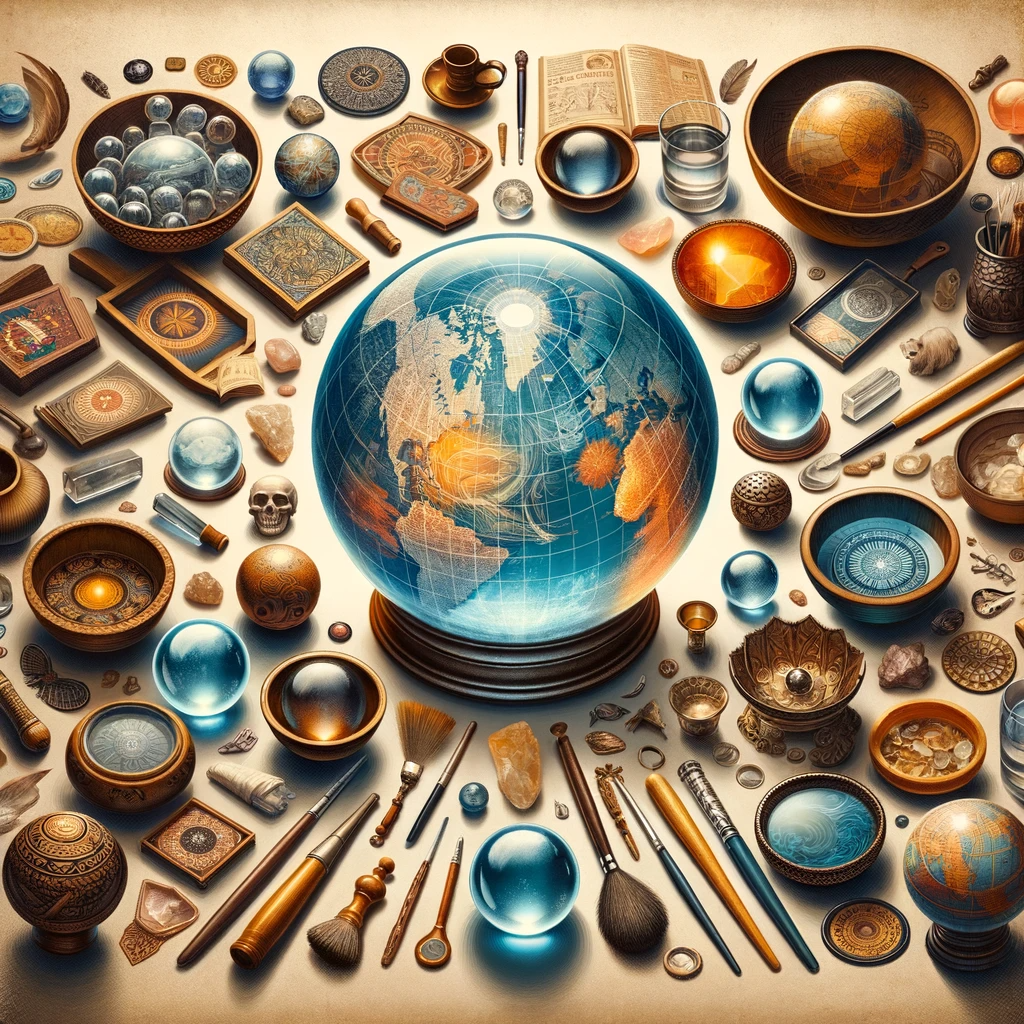Scrying in Different Cultures: A Worldwide Perspective

Scrying, also known as crystal gazing or seeing, is the ancient practice of looking into a reflective surface to gain insight, see visions, or receive messages. While scrying is often associated with crystal balls, it can involve any number of mediums including water, mirrors, flames, smoke, and more. The practice has profoundly shaped spirituality, divination, and mysticism across human cultures for thousands of years.

A Global Tradition
- Evidence of scrying has been found on every inhabited continent, dating back to ancient times. The widespread appeal of scrying lies in its accessibility – virtually anyone can gaze into an improvised reflective surface without extensive training or expensive tools.
- One of the earliest records of scrying comes from Ancient Mesopotamia where polished stones and vessels of water were used to connect with spiritual forces. The Mesopotamians believed water and stone could act as a portal to access divine knowledge.
- In Ancient Egypt, inky black obsidian mirrors were used for scrying and associated with the all-seeing eye of Egyptian gods like Horus and Ra. The god Thoth was said to scry into sacred wells.
- Scrying bowls used for divination were popular in the Hellenistic world of Ancient Greece and Rome. Sorcerers would pour holy water, ink, or oil into shallow bowls and interpret the shapes and visions that formed.
- In the Islamic world, scrying found its way into medieval alchemy and astrology. Alchemists practiced scrying to uncover transformational visions and receive mystic insights.
- Ancient Persians used a ritual water vessel called the Cup of Jamshid for scrying during royal coronations and astrological readings. The cup symbolized universal wisdom.
- The Vikings and Celts were known to practice hydromancy by gazing into turbulent waters to connect with spirits and foresee the future.
- In India, nephelemancy, divination by observing cloud shapes, was documented in Sanskrit manuals as early as the 5th century BCE.
- Indigenous cultures in North and South America would scry through fire, smoke, and obsidian mirrors used in shamanic rituals.
- In sub-Saharan Africa, scrying traditions included reading patterns in water’s ripples, sand, oil droplets, and glistening minerals like quartz crystal.
- In China, scrying has been practiced alongside Taoist and Buddhist meditative practices for thousands of years. The I Ching uses a mystical tool for scrying known as the shi mirror.
- Scrying remains widespread among contemporary pagans who use a variety of reflective tools from cauldrons and scrying mirrors to crystal pendulums and divination orbs.

Scrying Methods from Different Traditions
While scrying mediums are diverse, some of the most common worldwide include:
- Crystal Balls: The archetypal image of scrying, crystal spheres ranging from palm-sized to massive have been used for prophecy and clairvoyance in many cultures. Crystal balls are still popular today.
- Water: Scrying in water ranges from gazing into waves at the shore to using ritual bowls. Hydromancy connects the subconscious with water’s fluid, intuitive nature.
- Mirrors: Reflective surfaces like obsidian, black glass, silver, and cauldrons of liquid have served as portals to other realms during scrying sessions across the globe.
- Fire and Smoke: Interpreting flames, embers, and smoke is an ancient shamanic scrying method used for transcendent vision quests.
- Oil: Scrying oils like olive, sesame, or coconut were ritualistically dripped into water vessels and read as divination tools in the ancient world.
- Stones and Gems: Translucent, shimmering, or patterned minerals can induce trance states. Crystal quartz, obsidian, and imbued gemstones are common scrying stones.
- Clouds and Fog: Finding meaning in the shifting shapes of clouds, mist, and fog has been practiced as a form of weather divination in many regions.
- Shadows: Candlelight scrying by gazing at the wavering shapes of shadows cast on walls is an old mystical practice with variants across many traditions.

Scrying Purposes and Benefits
Why has scrying captivated spiritual seekers across so many diverse cultures? Some key motivations and perceived benefits include:
- Divination – Scrying is most commonly used to reveal insights about past, present, or future events and situations otherwise hidden or murky.
- Prophecy – Visions revealed in the scrying medium can unveil portents, omens, and glimpses of fate. This prophetic power provides guidance for big decisions.
- Spirit Communication – Scrying supposedly allows practitioners to connect with spirits, ancestors, demons, angels, gods, and other disincarnate beings by opening a window to their realms.
- Vision Quests – Immersive scrying journeys induce trance states leading to out of body experiences, mystical visions, and profound intuition.
- Inner Wisdom – By bypassing logical thought, scrying reveals voices, images, and truths from the deeper self. This allows discovery of one’s obscure desires and destiny.
- Healing – Therapeutic scrying calms the mind, centers awareness, and sometimes surfaces suppressed emotions needing to be addressed for wholeness.
- Focus – The act of meditative gazing enhances concentration, mental clarity, and psychological well-being.

Scrying in the Modern World
While scrying is an ancient practice, it remains appealing and relevant in the modern age. Contemporary pagans are especially drawn to scrying and have reinvigorated techniques from old world traditions. The New Age movement has also adopted scrying as a spiritual self-discovery practice. Those seeking to cultivate intuition amidst today’s chaotic distractions find scrying helps open psychic abilities and attune with the subconscious in profound ways. Its popularity endures because the human desire to find meaning, see the unseen, and unveil our deepest nature survives even in the rational modern world.
Scrying allows glimpses of realities that logical thought cannot access on its own. By honoring these irrational mysteries, scrying gives modern truth-seekers a window into their souls.
FAQ About Scrying
Q: What kinds of objects can be used for scrying?
A: Many reflective or translucent objects can be used including crystal balls, mirrors, water, bowls of ink or oil, crystals, gems, flames, smoke, and more. Even projected light can be a scrying medium.
Q: Is scrying the same as crystal ball gazing?
A: Crystal ball gazing is the most well-known type of scrying, but scrying can involve any reflective surface. Crystal balls are one of many tools used.
Q: Can anyone learn to scry or is it a supernatural ability?
A: With practice, most people can learn to scry. It does not require psychic powers but does involve allowing intuitive imagery and visions to surface. Patience and trust in one’s abilities allow scrying to unfold.
Q: What is the best way to get started with scrying?
A: Start with candlelight scrying by gazing into the flickering flame or at shadows cast on a wall by the candle. Meditate to relax your focus. Clear your mind but remain open to any impressions that arise without judgment or expectations.
Q: How accurate are the visions seen during scrying?
A: Images seen in scrying reflect the subconscious so their meaning and accuracy depends on the practitioner’s interpretive skills. Visions shouldn’t be taken literally but as symbols to decipher.
Q: Is scrying related to psychic abilities like clairvoyance?
A: Scrying awakens latent psychic senses and can be seen as training one’s clairvoyant skills. With practice, scrying enhances intuition and perceptiveness over time.
Q: What dangers or risks are associated with scrying?
A: Mentally unstable people should avoid scrying, as it can exacerbate psychological conditions. Otherwise, scrying is generally safe if practiced in a sound state of mind. Skepticism and rational detachment help avoid being misled.
